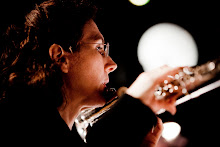I wanted to use this as a platform for my thoughts about non vibrato, because, well, playing without vibrato for many flutists is a disquieting prospect. It is no longer a novel concept - the Early Music movement has seen to that. However, I've run across a number of contemporary composers who use it as their esthetic, not only for flutists, but for the whole ensemble. It was also the contemporary music trend for ensembles in the 20th century, especially in the Netherlands. I'm not sure if Michel van der Aa is an heir to this tradition, or if his non-vibrato esthetic stems from the sound world of electronically produced sounds.
In any case, the challenge for me was to blend with three violins (also playing non vibrato) and with the other winds (clarinet, bassoon and trumpet). The violins and the flute are often in unison in the high register. No place to hide. The other challenge was the transparency of texture - this is music that has to sound, hmm, nice, for lack of a better word. Not pretty or sugary, but clear and listen-to-able. When a flutist thinks of sounding nice, they will add a shimmer or shine to the sound (i.e. vibrato), just as a person naturally smiles when trying to be nice. Vibrato is our smile, so to say. Without it, we are in danger of a death-like grimace.
I encounter this mortal danger in my studio, too. My students are pretty well behaved when it comes to preparing Baroque pieces. They do their homework, listen to traverso recordings, read Quantz, and sometimes dutifully stifle their vibrato. Stifle. That is the initial reaction to non vibrato. The sound is dead and flat, not only in intonation but in color. What is the trick to playing with a good, healthy, in-tune sound without vibrato? The dilemma of disquiet.
Now, the question of whether one should play Baroque music without vibrato on modern flute is a separate one. My answer to that is: one should played with a modified vibrato (which includes the possibility of non vibrato). If one is performing with a modern piano, I downright discourage complete non vibrato. (read why here)
To avoid death and poor intonation while playing non vibrato
- practice Moyse's de la Sonorite first with vibrato, then repeat non vibrato (B-A# with vibrato; B-A# without vibrato; etc...). The exercises "pour les sons graves" can be practiced in the same way. Make sure the tone quality and intonation of the non vibrato sound matches the sound with vibrato.
- anything that helps you to build support, such as harmonic exercises (those by Trevor Wye, Robert Dick, Peter Lukas Graf, and many more), or using the "Ha Ha Ha" (abdominal accents without tongue) articulation on scales or arpeggios.
- anything that will improve the resonance of your sound, such as singing and playing. The reason behind this: if you can manage to get all overtones of a note lined up, in tune and ringing freely, you should have a nice sound without having to add any wobble.



I have never really understood why flutists start from the end "how can I make a nice sound even if I remove vibrato?"… Historically vibrato (on wind instruments) has been somthing like an "ornament", somthing to add to a nice sound. Of the woodwinds, I guess clarinettists are the only ones who still go with that practice. Up to Marcel Moyse vibrato indeed was used in that way even by flutists, and we have to thank him for this "new" way of thinking sound on the flute… I really wish to go back to Taffanel's ideal of sound (at least the way he was preaching it, alas not the way we hear him play in late recordings…), or (better yet) to Fleury's ideal of sound…
ReplyDeleteBack to your "question". The basic thing, in my opinion, is a shift in perspective: it's not about going after "how to make a nice sound in spite of the lack of vibrato", but rather "make a nice sound; and then, when needed, make it sound nice even if adding some wobbling".
Easier said than done :)
A very interesting read for someone who doesn't play an instrument himself, but who certainly enjoys listening to the little subtleties within the music. Many thanks!
ReplyDelete